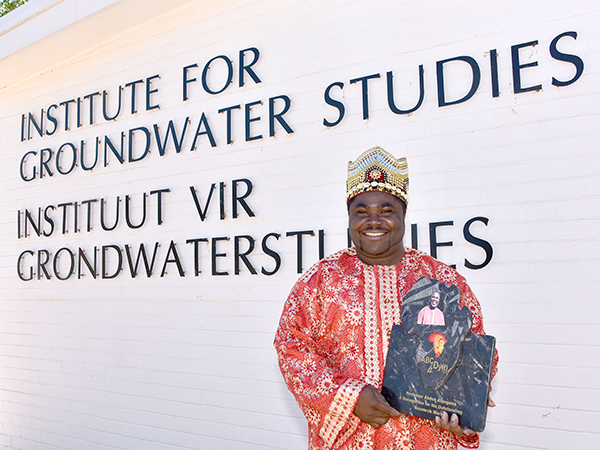
Prof Abdon Atangana from the UFS Institute for Groundwater Studies.
Photo: Supplied
Prof Abdon Atangana from the Institute for Groundwater Studies at the University of the Free State recently received the African Award of Applied Mathematics during the International conference "African’s Days of Applied Mathematics" that was held in Errachidia, Morocco. Prof Atangana delivered the opening speech with the title "Africa was a temple of knowledge before: What happened?” The focus of the conference was to offer a forum for the promotion of mathematics and its applications in African countries.
When Europeans first came to Africa, they considered the architecture to be disorganised and thus primitive. It never occurred to them that Africans might have been using a form of mathematics that they hadn’t even discovered yet.
Africa is home to the world’s earliest known use of measuring and calculation. Thousands of years ago Africans were using numerals, algebra and geometry in daily life. “Our continent is the birthplace of both basic and advanced mathematics,” said Prof Atangana.
Africa attracted a series of immigrants who spread knowledge from this continent to the rest of the world.
Measuring and counting
In one of his examples of African mathematics knowledge Prof Atangana referred to the oldest mathematical instrument as the Lebombo bone, a baboon fibula used as a measuring instrument, which was named after the Lebombo Mountains of Swaziland. The world’s oldest evidence of advanced mathematics was also a baboon fibula that was discovered in present-day Democratic Republic of Congo.
Another example he used is the manuscripts in the libraries of the Sankoré University, one of the world’s oldest tertiary institutions. This university in Timbuktu, Mali, is full of manuscripts mainly written in Ajami in the 1200s AD. “When Europeans and Western Asians began visiting and colonising Mali between the 1300s and 1800s, Malians hid the manuscripts in basements, attics and underground, fearing destruction or theft by foreigners. This was certainly a good idea, given the Europeans' history of destroying texts in Kemet and other areas of the continent. Many of the scripts were mathematical and astronomical in nature. In recent years, as many as 700 000 scripts have been rediscovered and attest to the continuous knowledge of advanced mathematics and science in Africa well before European colonisation.
Fractal geometry
“One of Africa’s major achievements was the advanced knowledge of fractal geometry. This knowledge is found in a wide aspect of Africa life: from art, social design structures, architecture, to games, trade and divination systems.
“The binary numeral system was also widely known through Africa before it was known throughout much of the world. There is a theory that it could have influenced Western geometry, which led to the development of digital computers,” he said.
“Can Africa rise again?” Prof Atangana believes it can.
He concluded with a plea to fellow African researchers to do research that will build towards a new Africa.